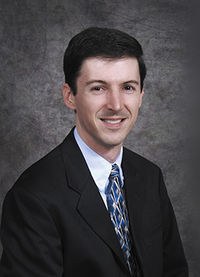Jason Lisle
| Jason Paul Lisle (Creation scientist and author) | |||
|---|---|---|---|
| |||
| Born | December 10, 1974 Cambridge, Guernsey County | ||
| Religion | Christian | ||
Jason Paul Lisle (born December 10, 1974)[1] is an astrophysicist who specializes in topics related to science and the defense of Christianity and creationism
In his ministry of science and Christianity, Jason Lisle demonstrates that any alternative to biblical creation is irrational and cannot make sense of the laws of logic, nor morality, nor the scientific method.
Originally from Cambridge in Guernsey County in eastern Ohio, Lisle was reared in a Christian home. He graduated from Ohio Wesleyan University in Delaware, Ohio, with a double major in physics and astronomy and a minor in mathematics. He then earned both Master of Science and Ph.D. degrees in astrophysics from the University of Colorado at Boulder, Colorado. A resident of Dallas, Texas, he has made several scientific discoveries, including the detection of giant cell boundaries. He also does theoretical research and has contributed to the field of general relativity. Lisle developed the definitive resolution of the starlight problem via the Anisotropic Synchrony Convention.[2] He is best known for his works which attempt to prove Christianity the superior to Charles Darwin's theory of evolution. he rejects the earth as billions of years old and instead believes that the planet was created some six thousand years ago.[3]
He is involved in the apologetics ministry, which defends Christianity from claims that its reveal truth is "unscientific," whereas Lisle sees science and Christianity as compatible in ever degree. His best known work is The Ultimate Proof of Creation, published in 2009. He earlier developed the planetarium program "The Created Cosmos" at the Creation Museum in Petersburg, Kentucky, at which he was employed by Answers in Genesis.[3] He has worked for the Rocky Mountain Creation Fellowship in Centennial, Colorado,[4] before he founded on July 14, 2017, the Biblical Science Institute[5] in Dallas, Texas.
Lisle has also analyzed films and television programs in the genre of science fiction. He contends that such programs are heavily influenced by what he calls "evolutionary mythology." Such films, he said "show extra-terrestrial life forms as having existed over billions of years. Many science fiction franchises seem to promote secular humanism quite heavily. And yet, despite all these anti-Christian themes, science fiction often portrays the Gospel of Jesus Christ in symbolic form." Lisle blames the inconsistency on the different worldviews of the Christian and pagan minds. He notes that unbelievers know God in their heart of hearts, but inconsistently suppress truth in unrighteousness.[6]
Lisle explains how Christians can win the hearts of non-believers though the creation debate:
All unbelievers are made in God's image. As such, they know in their heart of hearts the biblical God. God has built into them the knowledge that they should be consistent, non-arbitrary, rational persons. ... The unbeliever must live in God's universe and therefore must accept God's presuppositions in order to function. The unbeliever might deny being made in God's image, but he cannot escape it.[7]
Lisle further argues that defenders of the Christian faith detect arbitrariness in the secular worldview and follow a "Bible-first" approach to knowledge and reasoning, rather than the evolutionist's preferred "evidence-first" claim, for which no logical evidence exists.[8]
References
- ↑ Jason P. Lisle - Dallas, Texas. Mylife.com. Retrieved on June 1, 2018.
- ↑ "Anisotropic Synchrony Convention", Blogs.answersingenesis.org/blogs/jason-lisle, July 8, 2010; website no longer available.
- ↑ 3.0 3.1 About Dr. Lisle. Jasonlisle.com. Retrieved on June 1, 2018.
- ↑ Jason P. Lisle. Intelius.com. Retrieved on June 1, 2018.
- ↑ Biblical Science Institute. Evidenceforbelief.com. Retrieved on June 2, 2018.
- ↑ The Gospel in Hollywood, Part 2. Jasonlisle.com (March 31, 2017). Retrieved on June 1, 2018.
- ↑ Jason Lisle, The Ultimate Proof of Creation: Resolving the origins debate' (Green Forest, Arkansas: Master Books, 2009), p. 148.
- ↑ The Ultimate Proof of Creation, pp. 172-174.
